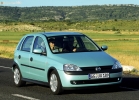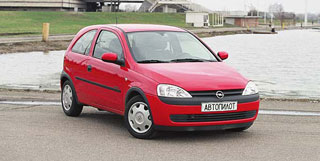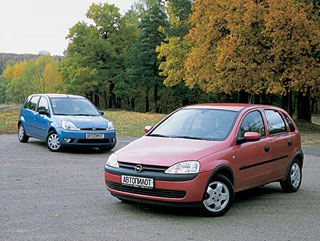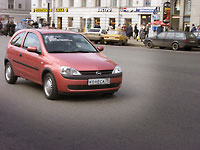Test drive Opel Corsa 5 doors 2000 - 2003 hatchback
The highest score of average sufficiency
I have long suspected that the consumer properties of the most massive cars slowly but surely move to a certain common parameter of medium size. Judge for yourself: the main ergonomic constants that form the basis of the general layout of the car (and, therefore, forms), the development of the workplace of the driver and the entire interior, are well known today. Technical characteristics are also brought closer, and therefore the operational indicators of classmates vary only by millimeters, grams and shares of seconds. Agree that this is fundamentally for sports, but not much of concern to the townsfolk, of which the majority in life. Technologies of modern robotic production is another equalizing all a comb. And the aerodynamics? True, the price that depends on the configuration remains, and the design, most clearly and weightily separating one product of the consumer goods (in the good sense of the word) from another.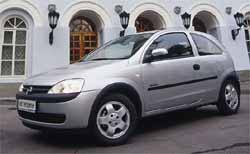
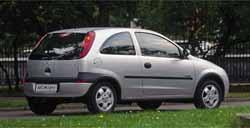
On the end of our test, cars, whose popularity does not knowingly determine the acceleration dynamics and the shape of the curve of the maximum torque of the engine. Meet the kings of megacities and evening traffic, as well as loyal friends and assistants to modern business women Opel Corsa 1.2 Comfort, Peugeot 206 XR and Skoda Fabia 1.4 MPI ELEGANCE. Without a doubt, the growing popularity of European class cars into a new, very indicative, trend in the domestic market. If earlier a small three- or five-door compact spoke that the owner is simply not able to purchase a full-size sedan, today such a machine is perhaps mainly a demonstration of rationalism and, if you like, material well-being. For, as a rule, the baby is the second or even the third car in the family. We did not even notice how the female characteristic began to relate to the characteristic, which has not been determined by the infantility of the structure and design for some time, because now their personal vehicles allow themselves more and more representatives of the beautiful half of the fundamental cell of society.
The price range of the entire three is in the range from $ 11,500 to $ 13,500, which theoretically builds the purchase of these cars to the rank of a rationally balanced act, free from the ambitions of prestige and inflated emotions. But this is a theory, but in practice everything looks somewhat different, and Peugeot Simpsaga, which today has the most exquisitely acute design, definitely leads in terms of prestige. The appearance of Skoda, at first glance, is more modest and drier, but this dryness is the essence of the style of techno, the language of which is more consonant with stiffness through the notorious realities of our time, and, in this regard, Fabia is primarily suitable for those who identify themselves with this world. Opel is in a sense an alternative, but one cannot fail to note the commendable struggle for the purity of the lines and the originality of the details in the appearance of the German. In a word, with the appearance of each machine, everything is in order. So, if you have bags and suitcases with you, then feel free to choose PEUGEOT: his trunk due to the lack of vertical elements of the suspension is noticeably more convenient than the rest. The fixing small luggage of the grid is available in all cars, which, together with the hard rear shelf, is the norm in this class. Before slamming the lid, I advise you to see where the reserve lies. For example, in order to change the wheel, from the Czech and German cars you will have to unload the baggage under the rug. And Peugeot will only have to stand on ... knees: a narrow doktka hangs on the street under the floor. Well, if you are cello? Nothing terrible seats of all cars are folded according to the 2/3 scheme known to all, and on the French car for this you do not even need to remove the rear head restraints.
But, as the American designer Raymond Loewy used, the car begins with the door handle. He is right, because slipping a hand under the plastic petals of the door handles Opel and Peugeot, you involuntarily tune in to the same plastic essence of the whole car. Skoda offers a pen option for a natural grip characteristic of large and solid German cars. Everything is just like that. The annoying texture of PEUGEOT plastic parts suppresses everything in the interior, including even a genuine sculpture, which is the shape of the internal door panels. Corsa also has plastic around, but neat and clean. But Fabia! .. I can’t even believe that you are sitting in a little car for $ 11,800. The Corsa doors are large and heavy, they are completely closed, and in order to do this operation the first time, it is necessary to practice. True, if it doesn’t work out, the purring of the nuclear power plant will be heard, which, incidentally, works when most modes change. The rest of the cars are not behind this sound plan, and, for example, it was precisely the harmonious voice of Fabia that I was warned about the sunbathing backup lamp. As expected, strict, business and clear devices are well read from everyone. But ergonomics by ergonomics, and landing in all three cars is noticeably different, and, for example, for fans of sitting, Skoda is intended higher, those who prefer a low landing (approximately like in a sports compartment) may opt for Peugeot. Opel Golden mean: to sit down and get out of the car easily and unrelenting.
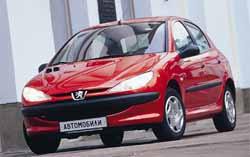
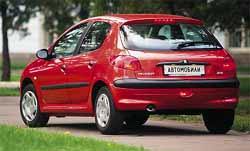
Although everyone has a multilift and all laid adjustments, the seats look somehow indifferently cold, you can eat something like a comprehensive lunch, but there will be no memories. The rudders are pleasant to the touch and lie well in the hand and, of course, are adjustable. We will now configure external mirrors. Skoda and Opel do not need to look for the setting handle on the driver's door, but at PEUGEOT this switch along with the buttons of the glass electric drive lurked between the seats, and to bring the skill of using it to automatism, there will be more than one day on the machine. As for the mirrors themselves, the most comfortable are on the French car, and the least in Czech, which, according to the old German habit, is significantly smaller than the left mirror. The internal helps driving only on Corsa, where, according to the conditions of the configuration, the rear head restraints were not installed; They were on other cars, and although their size is significantly smaller than the front facilities of the front, they overcome the review during parking. Before the trip, it would be nice to block the door locks, but it is easy to do this only on the 5-door Fabia, which has the corresponding key at hand, and the door lock on each door is equipped with a red LED alarm.
Now is the time to lay out small things: documents, a mobile phone, glasses and a notebook with a pen. There are no winners, everyone is taking care of a person, although in different ways. Peugeot has four open containers, and the largest of them are on the upper plane of the panel. The other three niches located on the central tunnel of the floor seemed not only some random, but also uncomfortable. Fortunately, there is a spacious glove with a multifunctional lid, in the cavity of which there is a fixed place for a handle, for glasses, and for documents. But he, here's the trouble, without a key. In the Czech and German cars, you can’t put anything on the panel from above (and that’s right!) Each thing has its own reliable storage. For example, on the left above the head of the driver Opel, a small container (with a lid) for glasses, and Fabia has a pretty drawer in the center of the console, which lovely ladies will surely take elegant and useful trinkets.
To start a modern car and move off, enough experience of a driving school, but to do it on Opel Corsa, equipped with an automatic EasyTronic automatic shift, it is first necessary to study the operating manual. And, believe me, this reading is drawn. Firstly, it is curious to find out that we have a standard equipment, and the usual mechanical box on the Corsa option! Secondly, Easytronic is not a classic automatic (under the selector handle you can’t see the usual designations p, n, r, d), and if the car does not move, then the gearbox is neutral. Therefore, do not forget to put Opel on a handbrake in the parking lot. Swinging the selector to the left, we revive the automatic of the switching mechanism. On the panel, not the usual letter D lights up, but, nevertheless, the rest, at first glance, is very similar. But only until the moment when the first is replaced by the second and so on. Having reached the treasured revolution threshold, when, in fact, you need to switch, the patented tool of Easytronic is somewhat frightened by a car that is strayed from a given pace, significantly slows down, switches, and then begins to accelerate again. After counting all five programs in this way, I thought that if you compare these switching with the manner of bypassing with the usual mechanical gearbox of one of my good friends, then yes! I am an innovation for this, but the classic machine gun, in my opinion, is better. Although, according to Opelian engineers, Easytronic does not take away the cherished engine capacity, has better accelerating dynamics and is more economical. I believe that you quickly get used to the good, especially since in the cunning algorithm of switching there is another manual option. Forward plus, everything is simple and it works clearly and clearly and clearly, not as an example of other abstruse structures of this kind that I had to ride during this time. As for competitors, Peugeot and Skoda were equipped with conventional mechanics (although they offer ordinary automatic transmission in the options), which worked clearly and did not cause any lines of adhesion to Fabia.
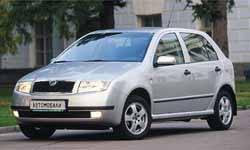
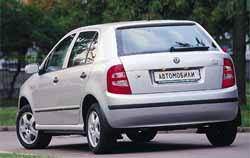
However, we go and, transplanting from the car to the car, mark the classical rigidity of the Germans (do not forget that Skoda is now also Volkswagen) and the no less classic intelligence of the Peugeot suspension, thanks to which the car unforgettably prescribed S-shaped ligaments of the turns. Corsa did not lag behind such fervent behavior, in which the driver could give the heat by moving the automatic control selector to the manual switching zone. For Fabia, I was a little offended: such a stylish outside and so impeccable inside, she did not agree to go dynamically and at a traffic light all the time lagged even for even smaller Opel and heavier Peugeot. I think that the reason for my rude handling with an elegant city car liability lies in the ... design of the dashboard of the Czech car. Both the style and quality like my beloved is dynamic Golf, but only you can go to VW as you want, and not as the car strangled by electronics allows ... driving along the highway equalized competitors, and at a speed of more than 100 km/ C of annoying factors remained only one inhabitant the noisy voice of the Peugeot engine, but its suspension! .. And the Corsa steering wheel and almost absolute silence inside Fabia, which was filled with elastic waryness? .. However, the steering wheel was also filled with it. But again, the city, where, getting out of the next traffic jam, you try to park, and then you get into traffic jams again ... However, this is the native element of the compacts. The glasses are raised, and air conditioners are included in the recirculation mode. A moment and all three cars are again indistinguishable (even according to the air conditioning settings algorithm), and again the thoughts climb into my head that they really differ only in the cost and style, and in fact the automotive industry is close to a certain standard of perfection, for which I I put the highest score with a light heart.
Text Nikita Rozanov photo Alexander Nozdrin
How do they look:
Nikita Rozanov
Outside:
When one of my friends first saw the Peugeot 206 on the streets of Moscow, he finally realized that the 21st century had come. Indeed, the brightness of the design of this car has become a symbol and a kind of bar that set the design level in the compact sector. However, competitors also did not doze off, and a year later, no less stylish Skoda Fabia appears in the European market, and a year later an elegant Opel Corsa. Apparently, the experience of Peugeot to transfer the style of the smallest model for the entire model line will be successfully used by both Czechs and Germans. All three cars are well identified both thanks to well -distinguished persons, and in the architecture of the main volume, which is a kind of muscles in Peugeot, some technocratic in Skoda and is elegant in Opel. Despite the fact that due to long noses and very short rear overhangs, the silhouettes of cars may seem close, they are nevertheless very peculiar: from the dynamically assertive Peugeot and a rapid Opel to a slowly restrained along Skoda lines. In the back of recognition, Corsa is the leader, and although its designers used a fairly widespread technique of vertical layout of the rear lighting equipment, the composition looks fresh and original.
Results:
Opel Corsa is very stylish and dynamic lines with which the shape is drawn, accurately characterize the display of the car, and such original details, such as the rear lights or the arch of the rear wheels, unusually resolved in shape, give it unique originality.
PEUGEOT 206 is an extremely integral and original design, which is simply impossible to confuse with style solutions of other manufacturers. In this regard, the car is suitable for everyone who cares about their image.
Skoda Fabia is a characteristic, developing style of technology design, a little lack of evaluation of an amateur. Some formality of plastic and pattern only enhances the originality and originality of the image.
Inside:
The inhabited space of all three cars is very originally repeated by the image found in external form. Peugeot mischievous and independent appearance, very accurately reflected in excellent ergonomics, of course, also influenced the artistry with which the entire composition of the instrument panel and doors was organized. The elegant Opel lines are also to be transferred inside, and the original drawing of the rear lighting technology echoes no less original in shape the central console and a pleasant three -spitting steering wheel, on which even the dry inscription Air Bag turns into a pretty ornament. The technocratic image of Fabia is brilliantly embodied in the cleanliness of the surfaces of the panel and the adaptability of the performance of the smallest details and switches. Car ups are also very diverse. If Peugeot has just a beautiful and functional sculpture, Opel has an almost naked function, then Skoda designers got into the middle ground everything is convenient, functional and very stylish, even a mischievous fabric of upholstery works. The seats on the cars of this market segment are traditionally not their pride, because the specifics of urban operation does not imply prolonged driving. Strong lateral and longitudinal support is not needed. The average adedal comfort is ensured, which is enough for the whole three, as they say, by the eyes. The luggage compartment of the hatchback part of the inhabited space, and, in this connection, its decoration was thought out no less carefully than in the cabin. And here everything is equally clean and most convenient as possible.
Results:
Opel Corsa is a good and stylish design, which, together with the good quality of materials and finishing, fully corresponds to the purpose of the car.
PEUGEOT 206 A rare combination of good style and excellent ergonomics, however, the picture spoils the overall level of assembly quality and a rough selection of embossing on plastic details.
Skoda Fabia is an excellent design of magnificent performance and quality, quality and quality again.
Source: Cars
Video test drive Opel Corsa 5 doors 2000 - 2003
Video Crash tests Opel Corsa 5 doors 2000 - 2003
Test drive Opel Corsa 5 doors 2000 - 2003
Opel Corsa 5 doors 2000 - 2003
Krassh Test: Detailed Information25%
Driver and passengers
9%
Pedestrians
Opel Corsa 5 doors 2000 - 2003
Opel Corsa 5 doors: Detailed information| Corsa 5 doors 2000 - 2003 | |
|---|---|
| Engine |  |
| Transmission |  |
| Control system and suspension |  |
| Brake system |  |
| Air heating and air conditioning |  |
| Launch and charging system |  |
| Electric components and so on |  |
| Corrosion body stability |

